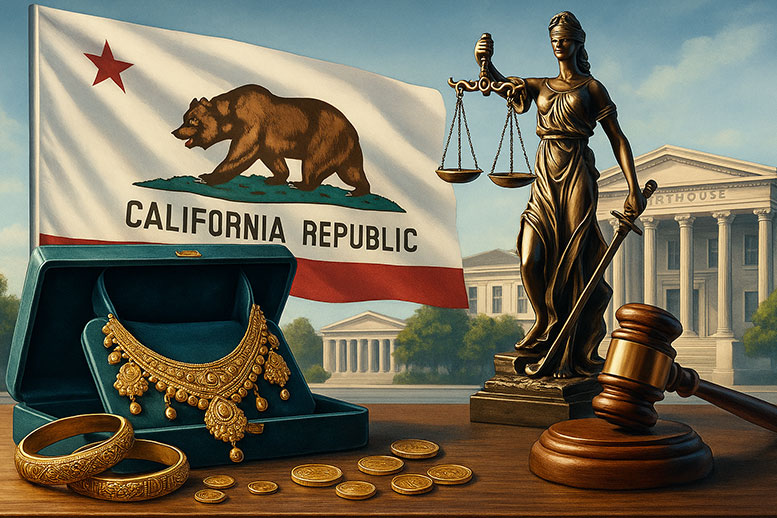Gold jewelry often holds immense emotional, cultural, and financial significance in Indian marriages. Known as stridhan, these gifts are traditionally given to a bride by her family and are considered her personal property under Indian custom. However, when a marriage ends in California, the handling of stridhan becomes far more complex.
At Bansmer Law, we have seen how these disputes can quickly escalate into emotionally charged and legally complicated battles. Whether the jewelry is being contested by in-laws, withheld by a spouse, or hidden overseas, resolving the matter depends entirely on California law—not tradition.
This blog provides a clear breakdown of how gold jewelry disputes unfold in Indian divorces filed in California courts, and how to protect your rights if you are facing this process.
Stridhan and California Law
In Indian culture, stridhan refers to the gold, jewels, and other valuables gifted to a woman at the time of her marriage. Traditionally, these items are viewed as the wife’s personal property, separate from marital assets.
However, California law does not automatically adopt this interpretation.
You see, California does not formally recognize stridhan as a legal category. Instead, the state applies its own community property laws, which divide assets based on when and how they were acquired.
If a spouse wishes to argue that certain jewelry is separate property—whether under the label of stridhan or otherwise—they must provide sufficient legal proof.
In other words, while courts may consider cultural practices when evaluating a dispute, those practices are not legally binding. All marital property is governed by the California Family Code and is subject to judicial discretion based on the facts of the case.
Community vs. Separate Property in a California Divorce
California is a community property state. This means that, in general, any assets acquired during the marriage are presumed to be jointly owned and therefore subject to equal division during divorce proceedings.
Gold jewelry may be considered separate property if it can be shown to have been:
- A gift to one spouse only, with no expectation of shared ownership
- Received before the marriage, such as a dowry or family inheritance
- Excluded through a valid prenuptial or postnuptial agreement
However, the burden of proof falls on the party claiming the item is separate. If jewelry was purchased during the marriage, used by both spouses, or stored with in-laws without documentation, it may be treated as community property—even if culturally considered stridhan.
For this reason, California Family Code Section 760 and related statutes are especially relevant in disputes over gold jewelry.
Proving Ownership of Gold Jewelry
Establishing ownership is a critical step in protecting your rights during divorce. Courts evaluate several types of evidence to determine whether a piece of jewelry belongs to one spouse individually or to the marital estate.
Examples of useful evidence include:
- Photographs or videos of the jewelry being gifted
- Purchase receipts or appraisal documents
- Gift letters from the bride’s family explicitly stating intent
- Documentation showing that the jewelry was kept in the recipient’s control
If gold jewelry was stored in a family member’s home, kept overseas, or used commonly during the marriage, the case becomes significantly harder to prove without written evidence.
Judges will assess not only the origin of the jewelry, but also how it was treated during the marriage. In many cases, even items that began as stridhan can become commingled with marital assets, which changes their legal status.
Disputes Over Missing, Hidden, or Sold Jewelry
Gold jewelry is frequently at the center of concealment and destruction claims in Indian divorces. One spouse may sell or hide the jewelry in anticipation of divorce, or may claim it was lost or gifted elsewhere. In some cases, in-laws become involved by refusing to return jewelry that was stored with them.
California courts take these allegations seriously. A spouse who hides or destroys marital property may face contempt of court charges, sanctions, or have their credibility damaged in the overall property division ruling.
Legal tools that may be used in these situations include:
- Forensic accounting to trace missing or sold gold
- Emergency motions for temporary restraining orders preventing asset dissipation
- Court orders compelling the return of identified property
While melted-down or resold jewelry is difficult to recover physically, courts may award equivalent value as part of the final settlement.
Cultural Considerations in a California Courtroom
Although California courts do not enforce Indian religious or cultural law, they may consider these elements as contextual background—particularly when supported by expert testimony, family witness statements, or cultural documentation.
However, this consideration is discretionary and cannot override the law. For example, a judge may listen to testimony from elders regarding the cultural meaning of a gold set, but will ultimately rule based on evidence of ownership, use, and intent under California statutes.
You should avoid assuming that cultural expectations will carry weight in court unless properly framed within the legal argument.
Protecting Gold Jewelry During Divorce
Proactive planning is often the best way to avoid conflict over gold jewelry in divorce. Steps you can take include:
- Appraise and photograph the jewelry shortly after the wedding or before separation
- Store high-value pieces in a neutral location, such as a safe deposit box in your name only
- Disclose all jewelry assets in mandatory financial disclosures, as failure to do so may harm your case
- Consult an attorney about filing a restraining order or protective order if you believe your jewelry is at risk of being taken or hidden
If you are not yet in the divorce process but fear future conflict, you may wish to formalize ownership through a postnuptial agreement or property declaration. A family law attorney can advise you on the best approach based on your situation.
You Deserve Legal Support That Understands Both Law and Culture
Gold jewelry disputes in Indian divorces are never simple. They involve deep cultural meaning, conflicting expectations, and serious financial consequences. In California, these matters are resolved not by tradition, but by evidence and the letter of the law.
At Bansmer Law, we provide culturally sensitive, legally rigorous representation to clients facing high-conflict divorces involving stridhan and gold jewelry disputes. We understand how to frame your concerns within California’s legal system, and we know how to build a case that protects your best interests.
To receive personalized legal guidance, schedule your 60-minute case consultation by calling us at (209) 474-2400 today.
FAQs About Gold Jewelry in Indian Divorces in California
What if the gold is in India and not in the U.S.?
California courts only have jurisdiction over assets located in the United States. However, they may consider foreign assets as part of the marital estate and assign value accordingly. Enforcing recovery of overseas assets can require international legal assistance.
What if I discover hidden gold after the divorce is finalized?
If significant assets were intentionally concealed during divorce, you may petition the court to reopen the case under California Family Code Section 2556. Courts can revise settlements based on newly discovered assets, especially if fraud is involved.
Can the husband claim stridhan in a California divorce?
Yes. Either spouse may claim the jewelry as community property unless it is proven to be the separate property of the other party. The concept of stridhan does not automatically shield the jewelry from division.
Can gold be considered a gift in California divorce cases?
Yes. If it can be shown that the gold was a gift intended for one spouse alone, it may be categorized as separate property. Clear documentation or testimony is essential in making this case.
Should I include gold jewelry in a postnuptial agreement?
Yes. A valid postnuptial agreement can establish gold jewelry as separate property and prevent disputes during divorce. However, it must meet California’s legal standards to be enforceable.
Can forensic accountants trace gold assets?
In many cases, yes. A forensic accountant may be able to trace the sale, conversion, or transfer of gold through financial records, bank statements, and purchase logs.
Can I get a restraining order to protect my jewelry?
Yes. If you believe your spouse may hide, sell, or destroy your jewelry, you can petition for a temporary restraining order to preserve property during divorce proceedings.
What happens if the jewelry was gifted by the groom’s side?
This does not automatically change its classification. California courts will still analyze who the intended recipient was, how it was used, and whether it was treated as shared property during the marriage.
How do courts handle emotionally charged gold disputes?
Courts focus on evidence and legal definitions, not emotions. That said, judges are often familiar with the cultural importance of these disputes and may allow limited testimony to provide context, especially if supported by clear documentation.
Can Indian courts help with California divorce cases?
No. California courts have jurisdiction over divorce proceedings filed in this state. However, if jewelry is being withheld by family members in India, a separate legal action may be necessary in that country.
Complexities like these are why it is so necessary to work with an experienced, strategic CA divorce attorney like Erica Bansmer. If you need legal assistance for a divorce—especially if gold jewelry is involved—call Bansmer Law today at (209) 474-2400 to schedule your consultation.


 CALL US NOW
CALL US NOW










